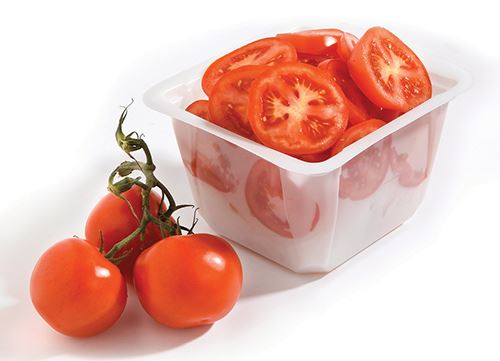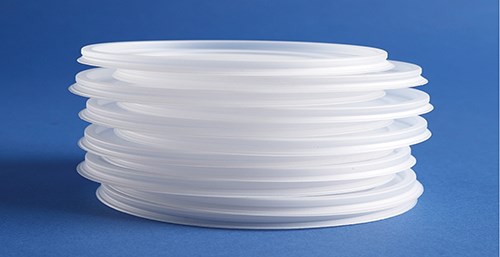PE/PS Interpolymer Modifies Polyolefins To Process Faster, Thinner, Better
Close Up: Materials
Novel hybrid of polyethylene and polystyrene acts as a processing aid for HDPE, LDPE, and PP.
If running “faster, thinner, better” sums up the goals of most plastics processors, then UPES resin additives may be just what they’re looking for. This novel hybrid of polyethylene and polystyrene acts as a processing aid for HDPE, LDPE, and PP. While it improves some polyolefin properties directly, its main benefit is to broaden the processing window of polyolefins. This can offer users significant economic benefits in downgauging, higher throughput, product quality, scrap reduction, and materials substitution.
UPES resin, a product of Nova Chemicals Inc., Monaca, Pa., was first launched in 2009, achieved commercial success in 2011, and now has around a dozen users, mostly in sheet extrusion and thermoforming. But a recent conversation with Shelly Martel, UPES global business director; Joseph Paolucci, business development and sales leader; and Daniel Purpura, application development and technical service specialist, indicate that the scope of UPES resin applications is expanding in a number of directions.
WHAT IT IS, HOW IT WORKS
UPES resin is an interpenetrating polymer network of PE and PS. It is made with Nova’s proprietary Qinnex technology, which allows combinations of normally incompatible ingredients. UPES is made in a reactor, where PE “seed pellets” are added to a solution where PS polymerizes throughout the pellet. The result is a much finer distribution of PE and PS phases than is possible with melt blending.
UPES resin comes in four product series and a total of six current grades. They contain varying ratios of PE and PS and thus range from relatively crystalline to relatively amorphous. One series (IP-73-UHP) also contains a third ingredient for added polarity to enhance printability and sealability of UPES/polyolefin blends.
In its main use to date, thermoformable sheet, typical addition levels of UPES resin are around 15%. UPES modifies the crystallinity of the matrix polymer (usually HDPE), creating amorphous regions that tend to heat and cool faster and draw better. This shows up as improved melt strength, lower processing temperatures, reduced shrinkage and warpage, and more uniform material distribution in formed parts. These effects go a long way to curing what thermoformers have told Nova Chemicals are their biggest headaches with polyolefins.
UPES resins cost in the range of $2/lb, but this is typically offset by cost savings through downgauging and throughput increases, according to Nova Chemicals sources.
UPES RESIN IN THERMOFORMING
At typical use levels around 15% in HDPE or PP sheet, UPES resin reportedly enables thermoformers to achieve an average of 20% to 30% faster cycles and sometimes up to 50% higher throughput. Startups are said to be much faster, and scrap generation is often reduced to half of previous amounts. While addition of UPES resin can impart somewhat higher stiffness and tensile and tear strengths, most of the benefit comes from more uniform drawdown and material distribution in formed parts. As a result, products can often be downgauged by up to 20% while also boosting crush strength of formed parts by up to 140%.
These advantages are illustrated in two recent commercial success stories. Nova Chemicals worked with sheet extruder Primex Plastics, Garfield, N.J., and thermoformer Tray-Pak Corp., Reading Pa. to develop deep-draw fresh-produce packaging and shallow-draw institutional food packaging. In the case of the fresh-produce pack, 15% UPES resin added to HDPE increased forming rates by 33% with enhanced part definition, faster startup, and lower scrap rate. More uniform draw allowed Tray-Pak to reduce the product thickness from 60 mils to 50 mils (17%) while simultaneously raising crush strength from 44 psi for the thicker parts to 103 psi for the downgauged parts—a 140% increase. What made that dual benefit possible was reduced thickness variation at key part locations. Comparing thickness variation of the thicker HDPE parts with the downgauged HDPE/UPES resin parts, Tray-Pak found:
•81% less variation in the bottom of the package;
•56% improvement in the bottom corner;
•73% improvement in the corner sidewall;
•69% improvement in the middle sidewall.
In the case of the institutional food package, Tray-Pak used 15% UPES resin to downgauge the HDPE product by 20% (from 25 mils down to 20 mils) while achieving 30% higher stiffness and 30% to 50% faster forming rates (depending on part size), faster startups, reduced scrap, and lower warpage.
While commercial thermoforming applications to date have been in HDPE, Nova Chemicals is about to announce a breakthrough in PP lids. Today thermoformed lids are typically in HIPS; but PP offers higher heat resistance and ESCR for use with hot foods or beverages with high fat content. The difficulties until now have been inability to extrude PP sheet thin enough, or to form it fast enough, to be economically viable. But with UPES resin modification, Nova says PP sheet has been extruded as thin as 11.5 mils, vs. 16-18 mils previously; and forming rates are much faster, though not quite equal to HIPS forming speeds. Addition of UPES reportedly has little effect on the heat resistance of PP or HDPE.
On the other side of the coin, Nova Chemicals sources point out that UPES resin might offer a respite from the extreme price volatility that PP has suffered of late. They are investigating potential substitution of UPES-modified HDPE for PP. Since shrinkage is similar in both cases, the same tooling might be usable.
NEXT UP: UPES RESIN IN HDPE FILM
Nova Chemicals says it has customers that will commercialize UPES-modified HDPE films by the end of this year. Benefits are said to include reduced energy consumption from lower melt temperatures, faster startups due to better bubble stability, potential for downgauging, and faster form/fill/seal operations downstream. In heavy-duty sacks, customers report that small amounts of UPES resin—2% to 5% of a multi-layer structure—improve creep resistance without compromising toughness. Better creep resistance improves the stability of filled sacks when stacked.
Other opportunities include use of UPES resin as a masterbatch carrier (already commercial). UPES reportedly can act as a “universal” carrier for additives used in both polyolefins and PS.
UPES has also seen limited use in LLDPE foams, where it has enabled lower densities without sacrificing mechanical properties.
Nova Chemicals is also beginning to look into the potential of UPES resin in blow molding. Though in the early stages, Nova is evaluating the possibility of lightweighting small bottles for personal-care products used as hotel amenities.
Even injection molding is a possibility for UPES resin additives, though Nova Chemicals is not yet currently able to support customers in this area.
Related Content
Understanding the ‘Science’ of Color
And as with all sciences, there are fundamentals that must be considered to do color right. Here’s a helpful start.
Read MoreExtruder Alignment: Important, but Only Half the Equation
The other half? Aligning and supporting downstream equipment. Here are best practices.
Read MoreUnderstanding Melting in Single-Screw Extruders
You can better visualize the melting process by “flipping” the observation point so that the barrel appears to be turning clockwise around a stationary screw.
Read MoreWhy Compression Ratio is Important
Compression ratios have been pretty much standardized over the years, based on what has typically worked before. But there are quite a few variables that must be considered in order to get the optimum performance from your screw.
Read MoreRead Next
Beyond Prototypes: 8 Ways the Plastics Industry Is Using 3D Printing
Plastics processors are finding applications for 3D printing around the plant and across the supply chain. Here are 8 examples to look for at NPE2024.
Read MoreRecycling Partners Collaborate to Eliminate Production Scrap Waste at NPE2024
A collaboration between show organizer PLASTICS, recycler CPR and size reduction experts WEIMA and Conair will seek to recover and recycle 100% of the parts produced at the show.
Read MorePeople 4.0 – How to Get Buy-In from Your Staff for Industry 4.0 Systems
Implementing a production monitoring system as the foundation of a ‘smart factory’ is about integrating people with new technology as much as it is about integrating machines and computers. Here are tips from a company that has gone through the process.
Read More























 (2).jpg;maxWidth=300;quality=90)







